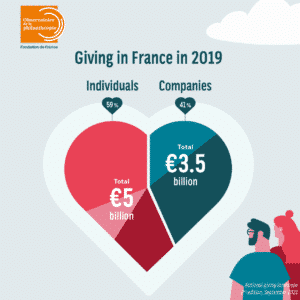1. Increased Giving Amounts from Overall Less Donors
Gross charitable contributions have remained steady in France, but the dynamics of philanthropy have shifted. While donors are giving a higher average gift than years past, the number of individuals making those gifts are declining.
Generational and socioeconomic demographics are at play: 32% of donors belong to the older subset of Baby Boomers, aged 70 and above, as compared to just 11% who are older Millennials between the ages of 30-39.
Additionally, while more affluent households account for 23% of the donor pool, they make up 43% of the charitable revenue. Wealthier donors are giving more frequently than those who make smaller incomes, yet are donating more proportionally of their gross income.
2. Corporate Contributions on the Rise
Between 2010 and 2019, corporate giving increased 119% – with the largest growth stemming from small businesses. In 2010, just over 28,000 companies officially declared their charitable giving. In 2019, it grew to over 104,000!
Corporate giving has reached 3.5 billion euros. The amount of donations deducted via corporate tax has significantly increased for smaller companies with under 250 employees.
This is largely driven by businesses with less than 10 employees that have seen the amount of their donations triple in 8 years, while the largest companies have proportionally dipped from 62% of all corporate donations in 2010 to 54% in 2018.

3. Planned Gifts are a Major Funding Source
Planned gifts (“Libéralités” in French), including bequests and life insurance, are growing steadily and represent a major source of charitable revenue for public benefit organizations.
While the gross contributions are staggering at 1.25 billion euros in 2019, giving is concentrated to a select few organizations. Seventeen organizations received 73% of planned gifts, primarily consisting of research and solidarity missions.
4. Diversified Fundraising Methods
Despite being on the decline, direct mail still generates most of the charitable revenue. However, organizations are diversifying their methods of soliciting and accepting donations and donors are following suit.
Some organizations hold events to engage their donors and raise funds for their mission, while others invest in online fundraising to reach new donors.
Online giving is currently not a major channel for French donors; however, the 2020 COVID-19 pandemic made digital fundraising more relevant than ever. Between 2015 and 2019, there was a 58% increase in donations raised online through crowdfunding.
This has led to new innovations in the fundraising area. The online gaming community has begun a fundraising marathon trend that is gaining in popularity.
Similarly, “No-cost” donations, while not tax-deductible, are gaining in significance, making up 8 million euros in charitable revenue. These funds are raised through advertising views or loyalty card points and are of no cost to the donor.
Additionally, micro-donations have raised 7.4 million euros in 2019 through the rounding up of purchases at a cash register, online shipping, or from monthly salary payments or bank accounts.
5. In-Kind Donations Kindly Given
Donations in-kind were estimated to reach 606 million euros in 2019, representing a significant source of donations – especially for charities whose mission is focused on solidarity, economic integration, or heritage (for example: museums and libraries).
Additionally, food banks and social service organizations benefit from donations in-kind of essential items like food, clothing, hygiene products, blankets, and more.
Charity in All Seasons
French philanthropy is on the rise, with 8.5 billion euros (over $9.5 million U.S. dollars) given in 2019 alone. Of the total revenue, 40% funded social, medical-social and health sectors, 23% went to religious causes, and 19% to education and research.
While most donations were directed to nonprofits (93%), gifts to public organizations (7%) have nearly doubled since 2012. Generally, gifts to the French State and its public institutions fund culture, hospitals, and municipalities.
Donors are not only responsive to their favorite causes, but to unforeseen emergencies. In 2018 and 2019, public organization gifts grew exponentially in response to Hurricane Irma relief and the Notre-Dame Cathedral fire. In 2020, an unprecedented call for donations was launched by charitable organizations and individuals around the COVID-19 – showing once more that many share Fondation de France’s goal to build a better world.




